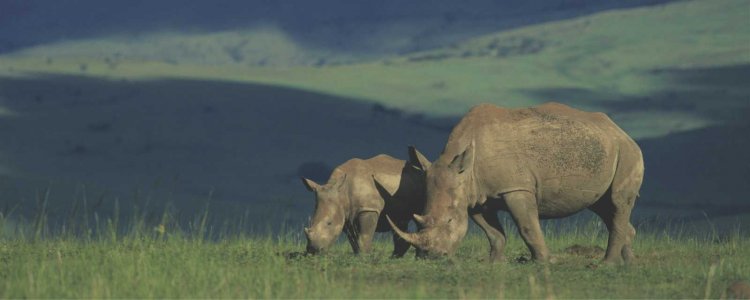INDIA RHINO VISION 2020
Launched in 2005 To attain a wild population of at least 3,000 greater one-horned rhinos spread over seven protected areas in the Indian state of Assam by the year 2020. Seven protected areas are Kaziranga, Pobitora, Orang National Park, Manas National Park, Laokhowa wildlife sanctuary, Burachapori wildlife sanctuary and Dibru Saikhowa wildlife sanctuary. Wild-to-wild translocations were an essential part of the Rhino Vision. Support from International Rhino Foundation, World Wide Fund - India, and the US Fish and Wildlife Service. The programme closed on 13th April 2021 with the release of two rhinos — an adult male and a female — in Assam’s Manas National Park transported from Pobitora Wildlife Sanctuary. The Indian Rhino Vision 2020 (IRV2020) program has come to a close with the recent translocation of two rhinos to Manas National Park in Assam. It was the eighth round of rhino translocation under IRV2020.

There are three species of rhino in Asia — Greater one-horned, Javan and Sumatran. Javan and Sumatran Rhino are critically endangered and the Greater one-horned (or Indian) rhino is vulnerable In IUCN Red List.
They are spread across India, Nepal, Bhutan, Indonesia and Malaysia. These countries are also known as Asian Rhino Range Countries.
Only the Great one-horned rhino is found in India.
At present, there are about 2,600 Indian rhinos in India, with more than 90% of the population concentrated in Assam’s Kaziranga National Park.
Indian Rhino Vision 2020 Launched in 2005, Indian Rhino Vision 2020 was an ambitious effort to attain a wild population of at least 3,000 greater one-horned rhinos spread over seven protected areas in the Indian state of Assam by the year 2020.
Seven protected areas are
- Kaziranga,
- Pobitora,
- Orang National Park,
- Manas National Park,
- Laokhowa wildlife sanctuary,
- Burachapori wildlife sanctuary
- and Dibru Saikhowa wildlife sanctuary
Wild-to-wild translocations were an essential part of IRV2020 – moving rhinos from densely populated parks like Kaziranga NP to ones in need of more rhinos, like Manas NP. It is a collaborative effort between various organisations, including the International Rhino Foundation, Assam’s Forest Department, Bodoland Territorial Council, World Wide Fund - India, and the US Fish and Wildlife Service.
Performance of the Program: The target of attaining a population of 3,000 rhinos almost achieved but the animal could be reintroduced in only one of the four protected areas planned. The plan to spread the Greater one-horned rhino across four protected areas beyond Kaziranga National Park, Orang National Park and Pobitora could not materialise.
The translocated rhinos helped Manas National Park get back its World Heritage Site status in 2011. 2018 and 2019 saw significant decreases in poaching, the results of forestry, local and national government officials coordinating efforts to combat wildlife crime across Assam.
About Greater One-Horned Rhino: There are three species of rhino in Asia — Greater one-horned (Rhinoceros unicornis), Javan and Sumatran. Poaching for the horns and habitat loss are the two greatest threats to the survival of Asia's rhinos. The five rhino range nations (India, Bhutan, Nepal, Indonesia and Malaysia) have signed a declaration ‘The New Delhi Declaration on Asian Rhinos 2019’ for the conservation and protection of the species.
Protection Status: Javan and Sumatran Rhino are critically endangered and the Greater one-horned (or Indian) rhino is vulnerable under the IUCN Red List. All three listed under Appendix I (CITES). Greater one-horned rhino is listed under Schedule I of the Wildlife Protection Act, 1972.
Habitat of Greater One-Horned Rhino: The species is restricted to small habitats in Indo-Nepal terai and northern West Bengal and Assam. In India, rhinos are mainly found in Kaziranga NP, Pobitora WLS, Orang NP, Manas NP in Assam, Jaldapara NP and Gorumara NP in West Bengal and Dudhwa TR in Uttar Pradesh.
DNA Database for Indian Rhinos The Ministry of Environment Forest and Climate Change (MoEFCC) has begun a project to create DNA profiles of all rhinos in the country.
The project is a subset of the Centre’s larger, ongoing rhino conservation programme. By 2021, the project’s deadline, the Indian rhino could be the first wild animal species in India to have all its members DNA-sequenced. The project will help in curbing poaching and gathering evidence in wildlife crimes involving rhinos. The database will be hosted in the Wildlife Institute of India (WII) headquarters in Dehradun.
National Rhino Conservation Strategy
It calls for active engagement between India and Nepal to conserve the Greater one-horned rhinoceros. The plan said the single population of rhinos in Sukla-Phanta (Nepal), Valmiki Tiger Reserve (India) and Chitwan National Park (Nepal) and Dudhwa (India) is separated by the political boundary between the two countries.
It asks for the management of the two population under the same protocol, instead of managing the two population separately. The plan calls for expanding distribution range as the occurrence of 90% of the rhino in one protected area is a cause of concern and conservation of existing and potential rhino habitats need to be made a national priority.
Indian Rhino Vision 2020
Launched in 2005, the Indian Rhino Vision 2020 is an ambitious effort to attain a wild population of at least 3,000 greater one-horned rhinos spread over seven protected areas in the Indian state of Assam by the year 2020.
Seven protected areas are Kaziranga, Pobitora, Orang National Park, Manas National Park, Laokhowa wildlife sanctuary, Burachapori wildlife sanctuary and Dibru Saikhowa wildlife sanctuary.
It is a collaborative effort between various organisations, including the International Rhino Foundation, Assam’s Forest Department, Bodoland Territorial Council, World Wide Fund - India, and the US Fish and Wildlife Service.
What's Your Reaction?









































































